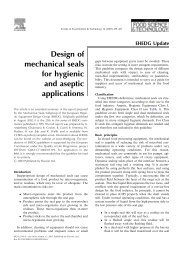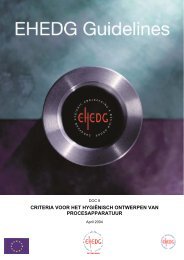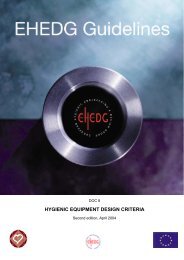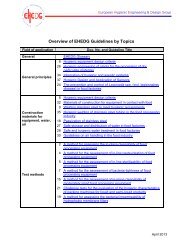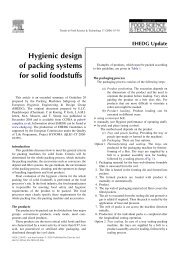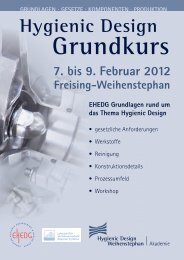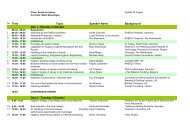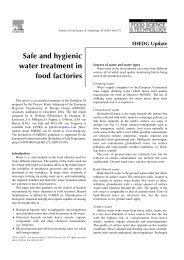Yearbook 2013/2014 - ehedg
Yearbook 2013/2014 - ehedg
Yearbook 2013/2014 - ehedg
You also want an ePaper? Increase the reach of your titles
YUMPU automatically turns print PDFs into web optimized ePapers that Google loves.
European Hygienic Engineering & Design Group<br />
Improved hygienic design and performance of food<br />
conveyor belts<br />
Olaf Heide, Habasit AG (Headquarters), CH - 4153 REINACH-BASEL, e-mail: olaf.heide@habasit.com<br />
Food conveyor belts can be found in nearly all industrial food<br />
processing and packaging lines. They are integral to ensuring<br />
a smooth and trouble-free process flow on the production<br />
line. For example, unexpected failures or breakdowns<br />
can be costly and cause severe problems in a continuous<br />
production. Hence, conveyor belts that are designed to<br />
be reliable and rugged in the production environment can<br />
contribute significantly to process efficiencies and profitability.<br />
Furthermore, they typically come into direct contact with food<br />
as an integral part of a process line, and therefore play an<br />
important role in terms of safe and hygienic food processing.<br />
The European Hygienic Engineering & Design Group<br />
(EHEDG) and all of its member companies aim to support<br />
and improve safe food production through hygienic design<br />
of equipment and components. Several leading conveyor<br />
belt manufacturers are members of EHEDG and actively<br />
contribute to various subgroups. As part of the equipment<br />
design process, EHEDG assesses hygienic design of<br />
dedicated belting solutions for direct food contact. An<br />
example is the Habasit HyCLEAN CIP system, Following<br />
thorough evaluation and implementation of improvements,<br />
EHEDG recently assigned for the first time a certificate of<br />
compliance to Habasit’s plastic modular belt types M5060<br />
and M5065 with sprocket and clean-in-place (CIP) system.<br />
All three components comply with hygienic design principles<br />
but utilise their full potential when incorporated as a package<br />
into food conveyors and equipment.<br />
Challenges related to food conveyor belts<br />
The vast variety of food products, processes, manufacturing<br />
methods and equipment requires belts that are able to cope<br />
with mechanical, chemical and environmental conditions.<br />
Each single aspect of production, from size, weight and<br />
shape, to consistency or temperature of conveyed goods,<br />
can have an impact on the performance and lifetime of<br />
a food conveyor belt. Needless to say, there is not one<br />
universal solution that can address all of these aspects. Belts<br />
have to be designed and selected for the intended use and<br />
associated requirements of the manufacturing operation.<br />
This article focuses on improving the hygienic design and<br />
performance of synthetic conveyor belts using plastic<br />
materials as a main design element, since steel belts<br />
follow a different design pathway and thus require separate<br />
considerations.<br />
If this is not done correctly it can cause process problems<br />
such as unexpected breakdowns, yield reduction, product<br />
and allergen contamination by foreign objects and/or<br />
microbial contamination and improper hygiene conditions.<br />
All of these aspects have an impact on the food processor’s<br />
costs and profitability.<br />
Scratched / damaged Plastic Surface damages on coated<br />
Modular Belt (Meat cutting line) fabric belt (Fish processing)<br />
Waste and soiled belt surface<br />
(dough processing)<br />
Fraying belt edges<br />
(Pizza processing)<br />
Figures 1. Things you do not want to see in a food process.<br />
Problems, as shown above, can be avoided by dedicated<br />
selection of belts for their specific application. There are<br />
many solutions on the market to improve durability, chemical<br />
resistance, good release of sticky goods and cleaning<br />
efficacy. But there is more to consider, including the three<br />
pillars of conveyor belt hygiene:<br />
• Food contact material legislation<br />
• Hygiene and food safety requirements<br />
• Impact of equipment hygienic design and cleaning<br />
Pillars of conveyor belt hygiene<br />
Food conveyor belt manufacturers not only must care for the<br />
design of their products, but also ensure that all materials<br />
used in belt construction comply with food contact legislation.<br />
It is especially important to understand and follow the<br />
requirements of regional legislation where food processes<br />
are located and/or where the equipment is put into operation.<br />
Many equipment and component manufacturers also maintain<br />
compliance with the US Food and Drug Administration (FDA)<br />
regulations pertaining to food-contact materials; however,<br />
these rules are not sufficient for operations in the European<br />
Union (EU). In Europe, the most important regulation is the<br />
framework directive EC 1935/2004 and its amendments,<br />
which cover materials and articles intended to come into<br />
contact with food. EU regulation 10/2011 (also known as<br />
Plastics Implementation Measure [PIM]) is a dedicated<br />
regulation governing the use of plastic materials, such as



